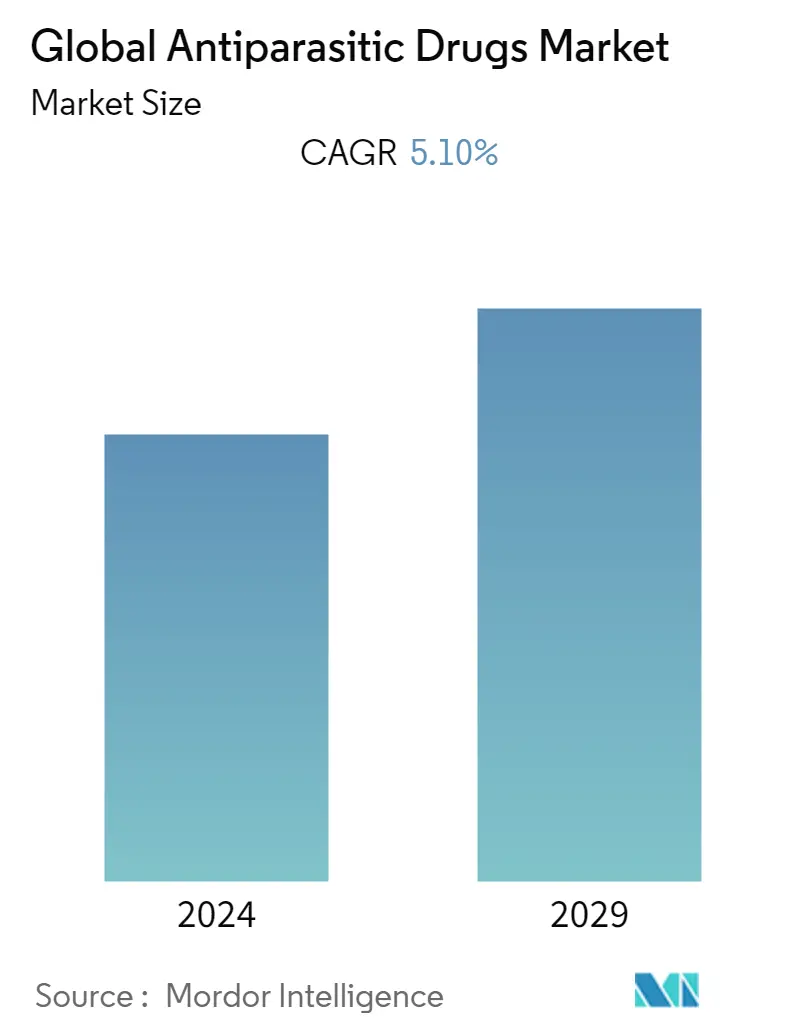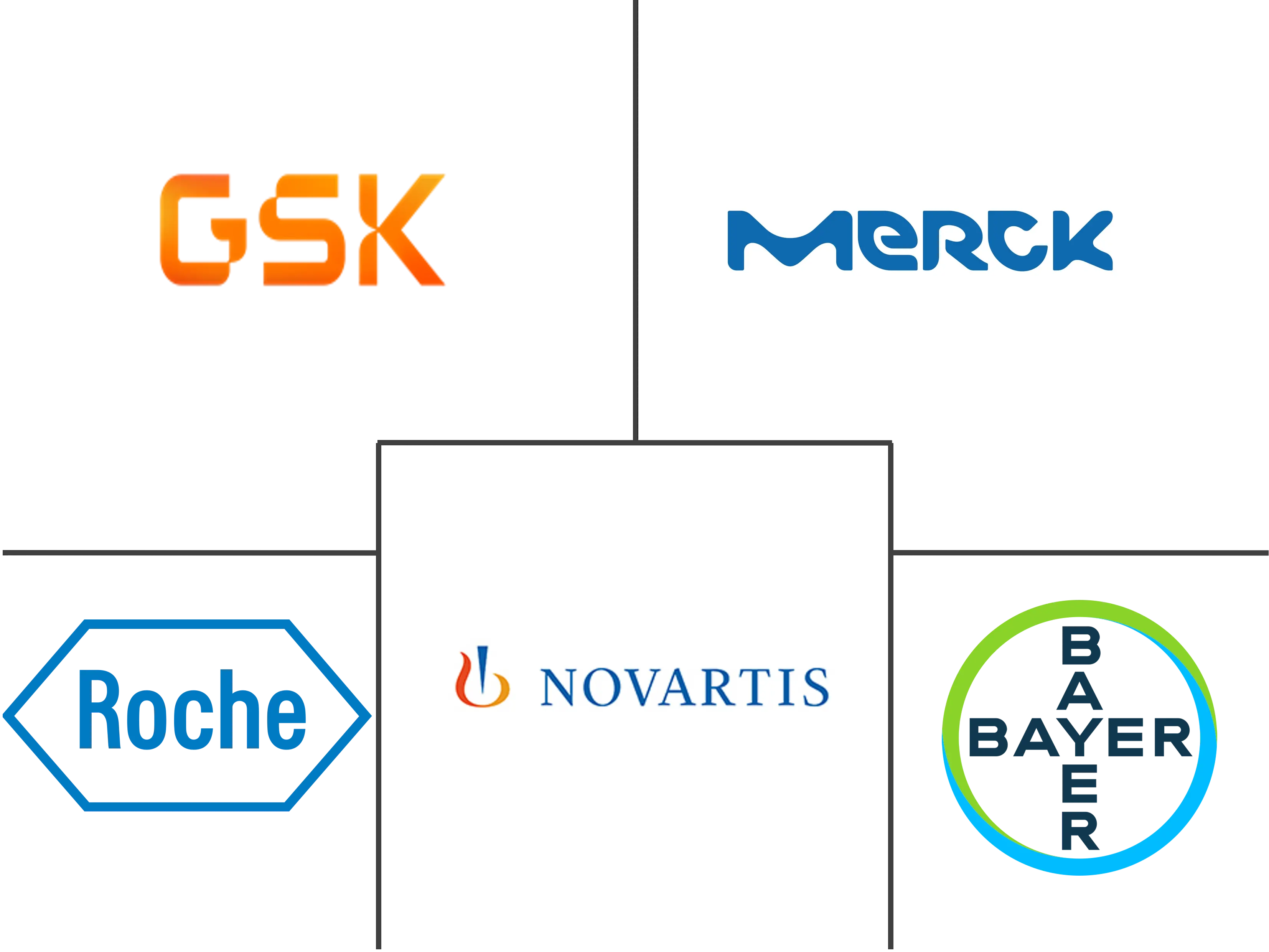Market Size of Global Antiparasitic Drugs Industry

| Study Period | 2019 - 2029 |
| Base Year For Estimation | 2023 |
| Forecast Data Period | 2024 - 2029 |
| CAGR | 5.10 % |
| Fastest Growing Market | Asia-Pacific |
| Largest Market | North America |
Major Players
*Disclaimer: Major Players sorted in no particular order |
Anti-Parasitic Drugs Market Analysis
The antiparasitic drugs market is projected to grow with a CAGR of 5.1% during the forecast period (2022 - 2027).
The COVID-19 outbreak has had a significant impact on the market. As employment closures have curtailed import and export activities, there has been a considerable influence on the market, resulting in shortages and unavailability of antiparasitic drugs and supplies across healthcare facilities. Due to the temporary shutdown of production facilities, export restrictions, increased demand for the COVID-19 medication, disruptions in the supply of goods, and interruptions in services, the impact of the outbreak in its initial phase on the antiparasitic drugs market was substantial. As per the data published by the World Health Organization (WHO), in 2020, most malaria-endemic countries faced moderate disruptions in anti-parasitic service delivery. However, the demand for treating COVID-19 with different drugs, such as antiviral and anti-parasitic, witnessed a significant boost in 2021. Clinical trials were undertaken to observe the effect of these drugs on novel coronavirus. For instance, according to the National Center for Biotechnology Information article titled "From hydroxychloroquine to Ivermectin: What are the Antiviral Properties of Anti-Parasitic Drugs to Combat SARS-CoV-2", published in February 2021, it was observed that chloroquine, hydroxychloroquine, artemisinins, and nitazoxanide showed some antiviral activity in vitro studies to reduce the viral replication stage by affecting cellular organelles.
Furthermore, according to the research study published by the British Heart Foundation, in April 2021, titled "Antiparasitic Drug Could Prevent Covid-19 Lung Damage," it was concluded that Niclosamide could protect cells against COVID-19-induced cell death. As per the same source, researchers observed that mefloquine demonstrates antiviral activity against coronaviruses by inhibiting the cytopathic effect of two coronaviruses closely related to SARS-CoV-2- the pangolin coronavirus GX_P2V/pangolin and feline coronavirus. The most effective drug among the anti-parasitic drug classes was Ivermectin, which was approved by the United States Food and Drug Administration (FDA) for therapeutic use among coronavirus patients. Likewise, according to the National Center for Biotechnology Information data, in April 2021, it was found that Ivermectin, an anti-parasitic drug, inhibited the SARS-CoV-2 virus growth by removing all the viral RNA from growing in cell culture within 48 hours. Therefore, initially, the growth of the anti-parasitic drugs market was hampered due to the government's restrictions on the COVID-19 pandemic. However, the market is anticipated to gain traction due to the increasing demand for antiparasitic drugs for treating COVID-19 patients and the growth in the number of drug trials for COVID-19 treatment.
Furthermore, major factors contributing to the growth of the antiparasitic drug market include the increasing prevalence of parasitic infections such as Chagas Disease, the surge in research and development activities of companies to launch antiparasitic drugs, and the initiatives taken by the government and non-profit groups to raise public awareness of parasitic infections and provide appropriate treatment. For instance, according to the World Health Organization (WHO) updates from April 2022, around 6-7 million people were diagnosed with Chagas Disease, a parasitic infection caused by the Trypanosoma cruzi parasite. Moreover, the World Health Organization announced a series of guidelines in June 2020 to control a parasitic neglected tropical disease, Schistosomiasis, to eliminate it as a public health problem by 2025 and make the world a "World Free Schistosomiasis."
In addition, the rising research and development activities and an increasing number of company collaborations for developing product pipelines are providing beneficial opportunities for the antiparasitic drugs market over the forecast period. For instance, in April 2021, Janssen Pharmaceutica NV collaborated with WEHI, an Australian Medical Research Center, to develop potential new antimalarial drug candidates. The collaborative research team discovered compounds with antimalarial activity within a collection of 80,000 drug-like molecules in the Janssen Jump-stARter Compound Library. The researchers towards potential antimalarial drugs are further developing the most promising candidates. Moreover, in May 2021, Bajaj Healthcare launched its new anti-parasitic drug, Ivejaj, which can be used to treat COVID infections. The company has received approval from India's drug regulator, DCGI, to manufacture and market the tablets. Additionally, in April 2021, Janssen Pharmaceutica NV collaborated with an Australian medical research institute, WEHI, to develop potential new antimalarial drug candidates. A collaborative research team discovered compounds with antimalarial activity within a collection of 80,000 drug-like molecules in the Janssen Jump-stARter Compound Library. The researchers towards potential antimalarial drugs are further developing the most promising candidates.
However, the adverse effects and risks associated with anti-parasitic drugs and a lack of awareness among the rural population in developing and underdeveloped economies are expected to hamper the growth of the antiparasitic drugs market.
Anti-Parasitic Drugs Industry Segmentation
As per the scope of the report, anti-parasitic drugs are used to treat various parasitic diseases, such as those caused by parasitic fungi, protozoa, helminths, ectoparasites, and amoeba, among many others. These drugs target and attack the parasitic agents of various infections and destroy or restrain their growth and development. The Global Antiparasitic Drugs Market is segmented by Drug Type (Anthelmintics, Antiprotozoals, and Others), Route of Administration (Oral, Injectable, and Topical), Distribution Channel (Hospital Pharmacy, Retail Pharmacy, and Others), and Geography (North America, Europe, Asia-Pacific, Middle East, and Africa, South America). The report offers the value (USD million) for the above segments. The market report also covers the estimated market sizes and trends for 17 countries across major regions globally. The report offers the value (USD million) for the above segments.
| By Drug Type | |
| Anthelmintics | |
| Antiprotozoals | |
| Others |
| By Route of Administration | |
| Oral | |
| Injectable | |
| Topical |
| By Distribution Channel | |
| Hospital Pharmacy | |
| Retail Pharmacy | |
| Others |
| Geography | ||||||||
| ||||||||
| ||||||||
| ||||||||
| ||||||||
|
Global Antiparasitic Drugs Market Size Summary
The antiparasitic drugs market is experiencing a dynamic phase, influenced by various factors including the COVID-19 pandemic, which initially disrupted supply chains and production but later spurred interest in the antiviral properties of these drugs. The market is expected to expand steadily, driven by the rising prevalence of parasitic infections such as malaria and Chagas Disease, alongside increased research and development activities. The demand for antiparasitic drugs has been bolstered by their potential application in treating COVID-19, with drugs like Ivermectin gaining attention for their antiviral properties. Collaborative efforts among pharmaceutical companies and research institutions are fostering the development of new drug candidates, further propelling market growth. However, challenges such as adverse effects, drug resistance, and limited awareness in certain regions may impede progress.
North America is anticipated to hold a significant share of the antiparasitic drugs market, supported by the increasing prevalence of parasitic infections and strategic initiatives by key players. The region's market growth is also fueled by heightened research and development activities and the migration of populations from endemic areas. Globally, major pharmaceutical companies are leading the market, leveraging their research capabilities and distribution networks to maintain a competitive edge. The development of new antimalarial drugs and combination therapies is expected to address the challenges posed by drug resistance, particularly in malaria-endemic regions. As the market evolves, the focus on innovative solutions and strategic collaborations will be crucial in meeting the growing demand for effective antiparasitic treatments.
Global Antiparasitic Drugs Market Size - Table of Contents
-
1. MARKET DYNAMICS
-
1.1 Market Overview
-
1.2 Market Drivers
-
1.2.1 Increasing Prevalence of Parasitic Infections
-
1.2.2 Increasing Investment in Research and Development Activities
-
-
1.3 Market Restraints
-
1.3.1 Adverse Effects and Risk Associated with the Drugs
-
-
1.4 Porter's Five Forces Analysis
-
1.4.1 Threat of New Entrants
-
1.4.2 Bargaining Power of Buyers/Consumers
-
1.4.3 Bargaining Power of Suppliers
-
1.4.4 Threat of Substitute Products
-
1.4.5 Intensity of Competitive Rivalry
-
-
-
2. MARKET SEGMENTATION (Market Size by Value - in USD Million)
-
2.1 By Drug Type
-
2.1.1 Anthelmintics
-
2.1.2 Antiprotozoals
-
2.1.3 Others
-
-
2.2 By Route of Administration
-
2.2.1 Oral
-
2.2.2 Injectable
-
2.2.3 Topical
-
-
2.3 By Distribution Channel
-
2.3.1 Hospital Pharmacy
-
2.3.2 Retail Pharmacy
-
2.3.3 Others
-
-
2.4 Geography
-
2.4.1 North America
-
2.4.1.1 United States
-
2.4.1.2 Canada
-
2.4.1.3 Mexico
-
-
2.4.2 Europe
-
2.4.2.1 Germany
-
2.4.2.2 United Kingdom
-
2.4.2.3 France
-
2.4.2.4 Italy
-
2.4.2.5 Spain
-
2.4.2.6 Rest of Europe
-
-
2.4.3 Asia-Pacific
-
2.4.3.1 China
-
2.4.3.2 Japan
-
2.4.3.3 India
-
2.4.3.4 Australia
-
2.4.3.5 South Korea
-
2.4.3.6 Rest of Asia-Pacific
-
-
2.4.4 Middle-East and Africa
-
2.4.4.1 GCC
-
2.4.4.2 South Africa
-
2.4.4.3 Rest of Middle-East and Africa
-
-
2.4.5 South America
-
2.4.5.1 Brazil
-
2.4.5.2 Argentina
-
2.4.5.3 Rest of South America
-
-
-
Global Antiparasitic Drugs Market Size FAQs
What is the current Global Antiparasitic Drugs Market size?
The Global Antiparasitic Drugs Market is projected to register a CAGR of 5.10% during the forecast period (2024-2029)
Who are the key players in Global Antiparasitic Drugs Market?
GlaxoSmithKline plc, Merck KGaA, Novartis AG, F. Hoffmann-La Roche Ltd and Bayer AG are the major companies operating in the Global Antiparasitic Drugs Market.

